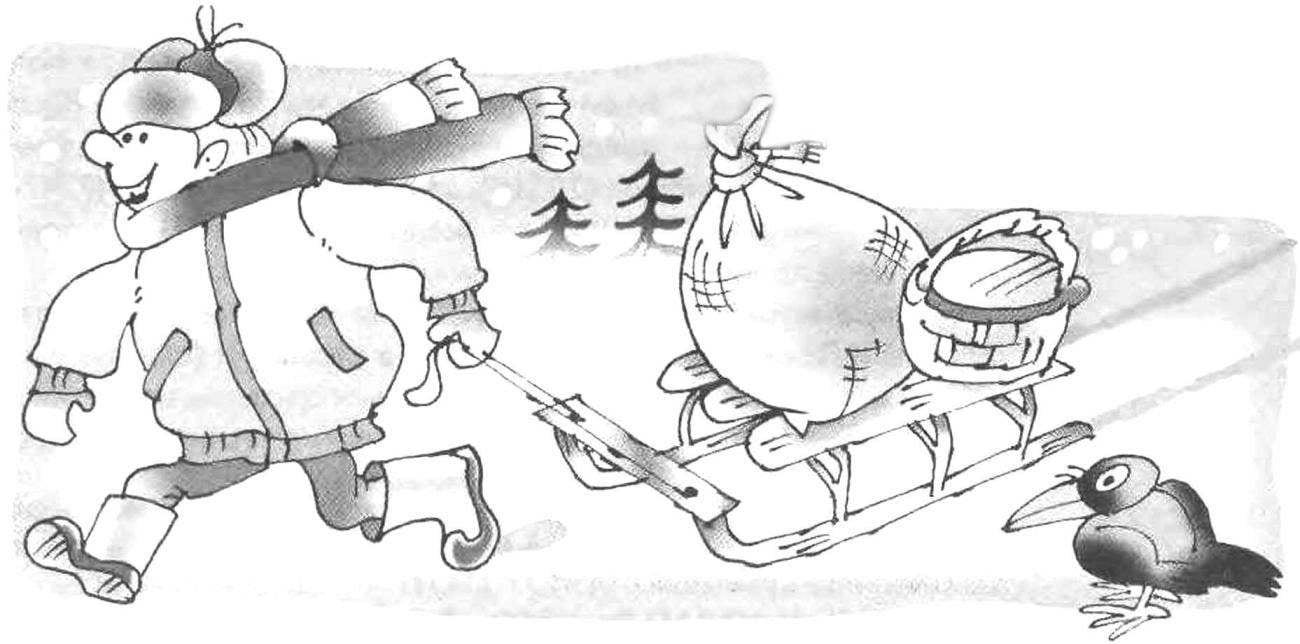Well, while doing these sleds, I realized that for the carriage of containers with water or other liquids, they are unsuitable, and this requires a different design. However, work was postponed until the following weekend, so without further ADO, at their own pleasure, surrender to the work of rusty metal. By the time the thought of another design of the water-cart and sled, measuring 40-liter aluminum flask, intended for use as container capacity, even put it in the sketch (Fig.2).
Next weekend, again enthusiastically took up the matter and by lunchtime production finished (except painting) is one of the slides — water related. In size they are less economic and simpler design. They have stands — they were replaced by the constraints from a thin pipe with a diameter of 14 mm. In principle, they do not even need and a Playground. The runners of these sleds made of steel pipes with outer diameter 30 mm, smoothly into the spreader bar welded between them from the same pipe, all three parts look like a single element.
Hand, as they say, already stuffed, and therefore cause controversy. But then came the relatives. They not only appreciated my work but asked to do the like.
Not to delay the case indefinitely, set about making the next sled. At the request of customers, they represented a symbiosis of the previous one: the size and design of the skid — like water-cart, and racks with a cargo platform — as economic. Here I note that just the day before purchased a device for exhaust studs. Here on these sleds and tested it by attaching the platform from 10 mm of plywood to the posts such rivets.
Fig. 3. Mini sleds:
1 — snake (steel pipe Ø30); 2 yoke (steel pipe Ø30); 3 — strut portal (steel pipe Ø14. 2); 4—platform (plywood s10); 5 —reins (rope Ø7); 6 — mounting platform to the posts-portals (exhaust rivet, 4 PCs.)
Fig. 4. “Off-road” sledge-sledge:
1 — snake (steel pipe Ø30,2); 2 — the bottom-the trough (sheet s1); 3 — yoke (steel sheet s3. 2); 4 — Board (sheet s1,2 pieces); 5 plug (wooden plug, 4 PCs.)
On made sled (Fig.3 in the photo) in the evening, guests and drove to his apartment a sack of potatoes and vegetables stored in our cellar. That’s just the paint on the sled has not had time to dry thoroughly.
And yet, no matter how good all the previous sleds, but they are suitable only for “sainokuni” or “ice” roads. For a snow virgin soil need other sled. We call them simply — a Leveller, but the North American Indians called them more loudly — the toboggan, and the name stuck for them as an international. Scraper has a different design. First, she doesn’t have skids, but because it is more like a trough. In this embodiment the scraper is unwieldy and its “puts” on each turn, especially at speed, when she, for example, hitched to a snowmobile. So my offroad skids also represent a symbiosis, but now of sleds and scrapers (Fig.4). The runners of the sleds, like toboggans, made of tubes of an external diameter of 30 mm and a truck chassis-trough — steel sheet with a thickness of 1 mm. At the sides of the trough has side and front and back yoke with openings for the passage of ropes securing the cargo. Traverses can be performed as flanging of bottoms, such as the folding of its edges doubled or even tripled. The runners are bent from both ends, that is, design is made on the principle of “push-pull”. The reins are fixed in the holes in the folded ends of the runners, and then the ends capped, wooden tubes, to the pipes did not get snow.
This scraper I made as a gift for his friend hunter as a trailer to the snowmobile. Not immediately photographed, and now this is not possible.
A. MATVEICHUK, Zavodoukovsk, Tyumen region.
 As soon as the first snow fell, it became clear that the house has no need of such cargo winter vehicle as a sled. Child’s sled for a long time “went” on a well-deserved rest in a pile of scrap metal, and weak they would have to carry the heavy loads.
As soon as the first snow fell, it became clear that the house has no need of such cargo winter vehicle as a sled. Child’s sled for a long time “went” on a well-deserved rest in a pile of scrap metal, and weak they would have to carry the heavy loads.
